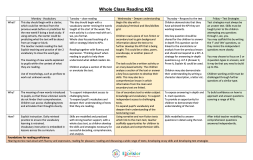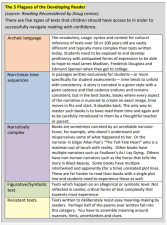Curriculum
Our Curriculum
Enjoy having a look at our innovative curriculum!
The documents below show the 'Big Ideas' for each learning unit and what will be covered within this. British Values are also incorporated into our planning along with a 'Wow' starter to engage children.
Our Curriculum Intent, Implementation and Impact Statement
The document below outlines what our aim is for our curriculum at Highters Heath, how we teach the it and what the impact of it will be.
Our Curriculum Overviews
Safeguarding in the Curriculum
At Highters Heath Community School safeguarding is our highest priority and is a golden thread that runs through everything we do. We use the curriculum in school to raise children's awareness of safety so that they understand how to stay safe and what to do if they feel unsafe. Please click here to access year group documents that illustrate how safeguarding is taught in the curriculum.
SMSC in Our Curriculum
SMSC is Spiritual, Moral, Social and Cultural development of the children in our school. This is not a separate subject that is taught explicitly but is an aspect of learning that should be present in lessons and behaviour in school. Some lessons lend themselves more easily to direct SMSC development such as Personal Development and RE, although this can be developed across the full curriculum. We also aim to develop SMSC through worship, behaviour expectations and our attitudes in school. Please see how we develop this below.
SMSC at Highters Heath Community School
Diversity Within Our Curriculum
At Highters Heath Community School, we strongly believe in the importance of preparing our children to thrive in the multi-cultural country and world we like in. We have therefore designed our curriculum to be inclusive and to celebrate the amazing diversity our city, this country and the world has to offer. Our curriculum is designed to promote a tolerance, respect and acceptance of the characteristics of the Equality Act 2010 (age, disability, gender reassignment, marriage and civil partnership and maternity, race, religion or belief, sex or sexual orientation) and to challenge stereotypes. This is achieved through discrete teaching and through incidental learning across the curriculum.
The use of the No Outsiders materials within our personal development lessons is a key part of our approach to teaching equality.

Music
All schools should have a music development plan, as set out in the national plan for music education. Please find a summary of our music development plan below.
Highters Heath Community School Music Plan 2024 - 2025
Subject Progression Maps
Please click on the subjects below to view our subject specific progression maps.
| ART |
|
Design and Technology | |
| Oracy | |||
| Personal Development | PE | RE | RWI Reading
|
| Science | Writing |
EYFS Curriculum
In Reception, at Highters Heath Community School, we plan our topics around the children’s interests. We look at their experiences and learning needs, as well as responding to upcoming seasonal events. We use Tapestry to regularly observe and assess the children, which we then use to ensure that future planning meets the identified needs of our cohort but also engages them in learning through their interests. These assessments/achievements are also shared with parents using this.
We follow the EYFS curriculum. Children learn through child-initiated play and adult directed activities throughout the unit. We believe that children should have the opportunity to work both indoors and outdoors, therefore at Highters Heath we have a well-equipped outdoor learning area and three members of our EYFS staff are forest school leaders.
Our unit is carefully planned, with both the indoor and outdoor areas providing opportunities for accessing all seven areas of the EYFS curriculum. We also have discrete lessons for maths, English and phonics. We create medium term plans for each half term to ensure coverage of objectives and development of skills across the curriculum. We have daily assemblies to promote British Values and SMSC whilst developing children’s oracy skills.
EYFS Curriculum Overview
EYFS to KS1 Progression Document
Phonics
Throughout EYFS and KS1, Phonics is taught using the Read Write Inc. Programme.
The programme follows a clear structure so that every day, children are learning about the sounds letters make, how to read (blending and segmenting words), spelling patterns, reading fluency and comprehension. Children are grouped and taught at the right pace and level for them.
This programme prepares the children for their phonics screening check at the end of Year 1. We continue to teach in this way until teachers decide their children are ready to move on to a more detailed reading approach (during Year 2).
In KS2 we use the Read Write Inc. Fresh Start programme for pupils who would benefit from phonetic reinforcement.
Reading
Reading is a fundamental skill for our children. The curriculum is designed to enable children to develop their reading skills. All lessons across the curriculum should incorporate elements of reading. Teachers plan their English lessons based upon high quality challenging texts and novels, most of which link to the termly topics the children are studying.
Whole class reading sessions are introduced at the end of Year 2 (when children are ready for these) and continue in Years 3 to 6. This allows children to continue to develop their reading skills and exposes them to increasingly complex extracts and complete texts. The structure of our week's reading lessons can be viewed by clicking on the image below.
At Highters Heath we expose children to the 5 plagues of a reader as outlined Doug Lemov's book 'Reading Reconsidered'. Click on the image below to find out more about these.
Our class reads in KS2 are shared using a programme called Just Read. These books are pitched just above the level of the highest readers in the class and they address also address aspects of the plagues of the reader.
Individual reading takes place regularly at our school, with the children who are less confident with reading receiving individual reading sessions daily. All children have access to our well stocked school library. This allows them the freedom to make text choices related to their own interests.
Writing
We encompass a three-stage pedagogy: ‘Immersion’ (where pupils learn and internalise texts, to identify transferrable ideas and structures), ‘Sentence Work’ (where pupils focus on developing their knowledge and skills of sentence structures), and ‘Independent Writing’ (where pupils use the skills taught to create original texts independently). These tasks aim to improve writing ability by giving pupils an understanding of the structure and elements of written language.
There are four purposes to writing (to entertain, to inform, to persuade and to discuss). In Years 1 and 2, only two text types are focused upon. The number of text types studied however builds up over time (see below) and over the course of their time at our school, our pupils experience the full range of these. The content of writing lessons is nearly always linked to the curriculum themes that our pupils are studying in their history and geography lessons. This allows our pupils to develop further and to consolidate their 'topic' knowledge within these curriculum areas.

Text Type Coverage Overview and Links to Topics
During the week, writing is taught though focused lessons on the development of handwriting (using the Letter Join Scheme); spelling (using lessons from Spelling Shed); vocabulary, grammar and punctuation (VGP) and composition (covering the writing elements identified in the previous paragraph) Please see the structure of a week below.

At Highters Heath, we have reduced the number of writing objectives each year group has to complete in a year to approximately 20. These are taught and embedded throughout the year. The expectation is that 100% of pupils, use these 100% accurately, 100% of the time by the end of the year. This is achieved through precise teaching, repeated practise of the skills and effective feedback.
Mathematics
Mathematics is one of the most important skills our children learn. Lessons are structured around the concrete – pictorial –abstract approach, providing opportunities throughout for discussion, using mathematical vocabulary, developing mathematical thinking and using multiple representations. There should be opportunities to record independently in every lesson (in workbooks and/or journals).
The teaching is episodic and whole class based, with all children being exposed to the same learning. Catch up sessions are led by teachers during lessons to ensure any misconceptions are addressed before moving onto the next small step in learning. Fact fluency sessions are led by trained teaching assistants at least twice a week in order to develop fluency with number facts and multiplication tables.
In Years 1 to 5, every child is provided with a Maths No Problem workbook and journal. These workbooks have been designed to meet the requirements of the National Curriculum, which supports the teaching for mastery approach. Teachers have access to the online planning resource which provides guidance on the structure of the lesson and representations to use.
In Year 6, children follow the aims of the National Curriculum, which builds on their fluency, reasoning and problem-solving skills. Independent tasks are selected and real-life contexts are used to apply their learning. Along with fact fluency sessions, arithmetic is focused on weekly where children explore efficient methods.
How maths lessons are structured at our school
At home, children are encouraged to use Times Table Rockstars (TTRS) to consolidate learning taught in school. Teachers set weekly tasks for children to complete and these are monitored by the Maths Lead. Each week, our class TTRS winners are awarded trophies for their completion of tasks in Year 2, Lower Key Stage 2 and Upper Key Stage 2.
Further Information
If you would like to know more about our curriculum please contact school directly or arrange a tour and see the curriculum in action!






